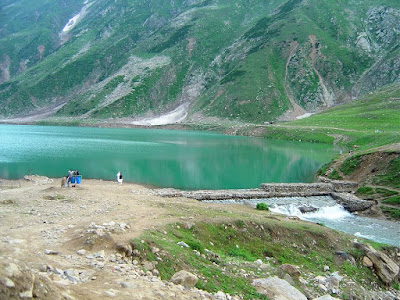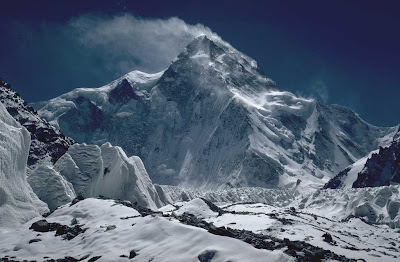The
name K2 is derived from the notation used by the
Great Trigonometric Survey.
Thomas Montgomerie made the first survey of the Karakoram from
Mount Haramukh, some 130 miles (210 km) to the south, and sketched the two most prominent peaks, labelling them K1 and K2.
The policy of the Great Trigonometric Survey was to use local names for mountains wherever possible and K1 was found to be known locally as
Masherbrum. K2, however, appeared not to have acquired a local name, possibly due to its remoteness. The mountain is not visible from
Askole, the last village to the south, or from the nearest habitation to the north, and is only fleetingly glimpsed from the end of the
Baltoro Glacier, beyond which few local people would have ventured. The name
Chogori, derived from two
Balti words,
chhogo ('big') and
ri ('mountain') (شاہگوری) has been suggested as a local name, but evidence for its widespread use is scant. It may have been a compound name invented by Western explorers
or simply a bemused reply to the question "What's that called?"
[6] It does, however, form the basis for the name
Qogir (
simplified Chinese:
乔戈里峰;
traditional Chinese:
喬戈里峰;
pinyin:
Qiáogēlǐ Fēng) by which Chinese authorities officially refer to the peak. Other local names have been suggested including
Lamba Pahar ("Tall Mountain" in Urdu) and
Dapsang, but are not widely used.
Lacking a local name, the name
Mount Godwin-Austen was suggested, in honour of
Henry Godwin-Austen, an early explorer of the area, and while the name was rejected by the
Royal Geographical Society it was used on several maps, and continues to be used occasionally.
The surveyor's mark, K2, therefore continues to be the name by which the mountain is commonly known. It is now also used in the Balti language, rendered as
Kechu or
Ketu(
Urdu:
کے ٹو). The Italian climber
Fosco Maraini argued in his account of the ascent of
Gasherbrum IV that while the name of K2 owes its origin to chance, its clipped, impersonal nature is highly appropriate for so remote and challenging a mountain. He concluded that it was...
"...just the bare bones of a name, all rock and ice and storm and abyss. It makes no attempt to sound human. It is atoms and stars. It has the nakedness of the world before the first man - or of the cindered planet after the last."
Climbing routes and difficulties
There are a number of routes on K2, of somewhat different character, but they all share some key difficulties. First, of course, is the extreme high altitude and resulting lack of oxygen: there is only one-third as much oxygen available to a climber on the summit of K2 as there is at sea level. Second is the propensity of the mountain to experience extreme storms of several days' duration, which have resulted in many of the deaths on the peak. Third is the steep, exposed, and committing nature of all routes on the mountain, which makes retreat more difficult, especially during a storm. Despite many tries there has been no successful ascent during the winter. All major climbing routes lie on the Pakistani side, which is also where the base camp is located.
Abruzzi Spur
The standard route of ascent, used far more than any other route, is the Abruzzi Spur, located on the Pakistani side, first attempted by Luigi Amedeo, Duke of the Abruzzi in 1909. This is the southeast ridge of the peak, rising above the Godwin Austen Glacier. The spur proper begins at an altitude of 5,400 m/18,000 ft), where Advanced Base Camp is usually placed. The route follows an alternating series of rock ribs, snow/ice fields, and some technical rock climbing on two famous features, "House's Chimney" and the "Black Pyramid." Above the Black Pyramid, dangerously exposed and difficult to navigate slopes lead to the easily visible "Shoulder," and thence to the summit. The last major obstacle is a narrow couloir known as the "Bottleneck," which places climbers dangerously close to a wall of seracs which form an ice cliff to the east of the summit. It was partly due to the collapse of one of these seracs around 2001 that no climbers summitted the peak in 2002 and 2003.
On August 1, 2008, a number of climbers went missing when a serac in the Bottleneck snapped and broke their ropes. Survivors were seen from a helicopter but rescue efforts were impeded by the high altitude. Eleven were never found, and presumed dead

Routes
- Northeast Ridge (long and corniced; finishes on uppermost part of Abruzzi route), 1978.
- West Ridge, 1981.
- Southwest Pillar or "Magic Line", very technical, and second most demanding. First climbed in 1986 by the Polish-Slovak trio Piasecki-Wróż-Božik. Since then the Catalan Jordi Corominas was the only successful climber on this route, despite many other attempts.
- South Face or "Polish Line" (extremely exposed and most dangerous). In 1986, Jerzy Kukuczka and Tadeusz Piotrowski summitted on this route. Reinhold Messner called it a suicidal route and no one has repeated their achievement. "The route is so avalanche-prone, that no one else has ever considered a new attempt."
- Northwest Face, 1990.
- Northwest Ridge (finishing on North Ridge). First ascent in 1991.
- South-southeast spur or "Cesen route" (finishing on Abruzzi route. A possibly safer alternative to the Abruzzi Spur because of avoiding the first big obstacle on Abruzzi called Black Pyramid ), 1994.
- West Face (technically difficult at high altitude), done by a Russian team in 2007
























































